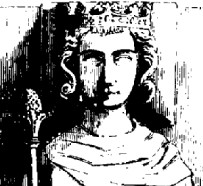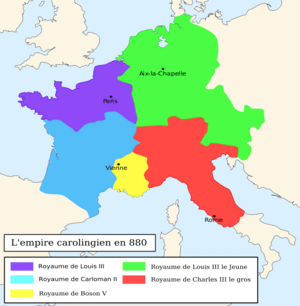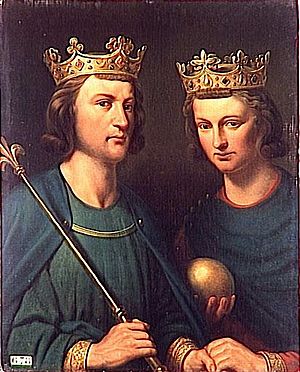Louis III of France facts for kids
Quick facts for kids Louis III |
|
|---|---|
 |
|
| King of West Francia | |
| Reign | 10 April 879 – 5 August 882 |
| Coronation | September 879 |
| Predecessor | Louis the Stammerer |
| Successor | Carloman II |
| Co-Monarch | Carloman II |
| Born | 863/865 St Denis |
| Died | 5 August 882 St Denis, Île-de-France, Neustria |
| Burial | Basilica of St Denis |
| Dynasty | Carolingian |
| Father | Louis II |
| Mother | Ansgarde of Burgundy |
Louis III (born between 863 and 865, died August 5, 882) was a king of West Francia. This kingdom was an early version of France. He ruled from 879 until his death in 882. Louis became king after his father, Louis the Stammerer, passed away. He ruled West Francia together with his brother, Carloman II.
Louis was in charge of the northern part of West Francia, known as Neustria. This area included the important city of Paris. His brother Carloman ruled the southern part, called Aquitania. Louis's time as king was short but important. He was especially known for his military victories, like defeating the Vikings in August 881.
Early Life and Becoming King
Louis was the oldest son of Louis the Stammerer and his first wife, Ansgarde of Burgundy. He was born when his father was the King of Aquitaine. At that time, his grandfather, Charles the Bald, was ruling West Francia. Some people wondered if Louis was truly meant to be king because his parents had married secretly. His mother, Ansgarde, was later set aside by his grandfather's wishes.
When Charles the Bald died in 877, and then Louis the Stammerer died on April 10, 879, the nobles of West Francia had a decision to make. Some thought Louis should be the only king. However, others believed that each brother should rule a different part of the kingdom. In September 879, Louis and his brother, Carloman, were both crowned at Ferrières Abbey.
Military Victories
On February 2, 880, Louis faced a defeat by the Vikings at the Battle of Lüneburg Heath. But things soon changed. In March 880, at a meeting in Amiens, Louis and his brother officially divided their father's kingdom. Louis received the northern and western areas, known as Neustria. His brother Carloman received the southern and eastern parts. Around this time, Duke Boso, a powerful leader, decided he would no longer follow either brother. He was then chosen as the King of Provence.

In the summer of 880, Louis and Carloman joined forces to fight against Boso. They successfully captured Mâcon and the northern part of Provence. They then met up with their cousin, Charles the Fat, who was ruling East Francia and the Kingdom of Italy. Together, they tried to capture the city of Vienne from August to November 880, but they were not successful.
In 881, Louis III and Carloman achieved a great victory against the Vikings. These Viking attacks had been happening since their grandfather's time. The battle took place at Saucourt-en-Vimeu. This victory was so celebrated that a poet wrote a short poem about it within a year. The poem, called Ludwigslied, praised the king for his bravery and religious devotion.
Death and Legacy
Louis III was very young when he achieved his great successes, only about 16 or 17 years old. His exciting victories against the Vikings made him very popular with the people of West Francia. He was especially loved in Neustria, the part of the kingdom he ruled.
Louis III died on August 5, 882, when he was around 17 years old. He passed away in Saint-Denis, which was in the center of his kingdom. He was chasing after a girl when he accidentally hit his head on the top part of a low doorway. He died later from this injury. Since Louis III did not have any children, his brother Carloman II became the only king of West Francia. Louis was buried in the royal burial place at the Basilica of Saint-Denis.
See also
 In Spanish: Luis III de Francia para niños
In Spanish: Luis III de Francia para niños
- Charles VIII of France, another French king who died after hitting his head on a doorway.
- Carloman II, Louis III's brother and successor.
Sources
- Bartlett, Robert (2020). Blood Royal: Dynastic Politics in Medieval Europe. Cambridge University Press.
- Jackson, Richard A., ed. (1995). Ordines Coronationis Franciae. 1. University of Pennsylvania Press.
- McKitterick, Rosamond (1999). The Frankish Kingdoms under the Carolingians. Pearson Education Limited.
- "Chronology: 881". Vikings: An Encyclopedia of Conflict, Invasions, and Raids. (2022). ABC-CLIO.
- Nelson, Janet L. (2000). "Carolingian royal funerals". Rituals of Power: From Late Antiquity to the Early Middle Ages. Brill.
- Venning, Timothy (2017). A Chronology of Early Medieval Western Europe: 450–1066. Routledge.
- Green, Dennis H. "The Ludwigslied and the Battle of Saucourt", in Judith Jesch (ed.), The Scandinavians from the Vendel Period to the Tenth Century (Oxford: Boydell Press, 2002), 281–302.
- Fouracre, Paul. "The Context of the Old High German Ludwigslied", Medium Aevum, 46 (1985), 87–103.
- MacLean, Simon. Kingship and Politics in the Late Ninth Century: Charles the Fat and the end of the Carolingian Empire. Cambridge: Cambridge University Press, 2003.
|
Louis III of France
Born: 863x65 Died: 5 August 882 |
||
| Preceded by Louis II |
King of West Francia 10 April 879 – 5 August 882 with Carloman II |
Succeeded by Carloman II |


